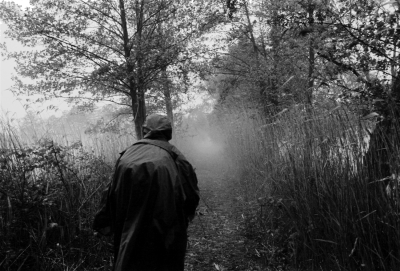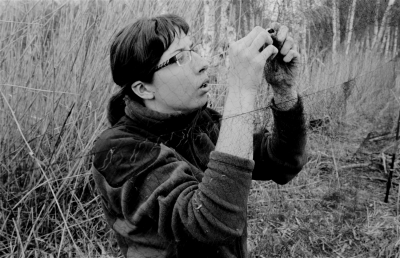 2006
2006
 2008
2008
 2010
2010
 2012
2012
 2014
2014



 |
Hanging around with Penduline tits
‘Should I stay or should I go? - Reproductive strategies in penduline tits (Remiz pendulinus)’
Robert Pawliszko – author of photographs,
Beata Czyż – project manager Searching in the fog – every day there is work in the field, no matter if it rains or the sun is shining. In the net – ornithological mist-nets allow us to catch birds.
|

|
Description popularizing the research project
In early spring, in March, tiny nimble birds start bustling among the long twigs of weeping willows over the rivers and ponds. They are males of penduline tits. They have a lot of work to do and very little time. They are supposed to build one of the most intricate constructions in the world of birds – a soft and fluffy mitten-like nest suspended from a thin twig of a willow. They have to hurry up, as other males do not cease to collect willow and poplar catkins weaving their elaborate nests nearly touching the surface of water. After some time, when green covers the plants, the nests will not be so easy to spot among the leaves. Even if somebody succeeded in finding the nest, it could turn out to be uninhabited in spite of the fact that it is the middle of breeding season. It happens that the males, once having finished one nest, start building another. The extra ones come in handy as the birds often abandon their nests, even with eggs already laid, and start a new clutch with new partners. Unfortunately, none of the parents does come back to the abandoned eggs.
The policy of abandoning their clutch refers to both males and females. Although males do it more often, females do it too. The seemingly incomprehensible lack of parental instinct and tendency to waste energy must have their explanation. It is probably strategy of the best allocation of their genetic material. Thanks to such a policy, their offspring once adult will have the right combination of qualities of their parents. Next spring new nests will swing suspended over water. Every year they are the best proof that the strategy of changing partners is efficient enough to ensure survival of penduline tits.
Abstract
Briding system of the vast majority of birds is social monogamy with biparental care. Penduline tit, which is the object of our research, is one of exceptions. Breeding system of this species is ambisexual polygamy with uniparental care. Each individual faces a dilemma whether to take care of the offspring or desert them and look for a new mate. Our research is conducted at Milicz ponds in the SW Poland. Penduline tits are individually marked with a combination of three colour rings and a metal ring with an individual code. We search the study area for new nests and control previously found ones. We determine the number of eggs, nestlings and fledglings, which allows determining reproductive success of the individuals. We analyzed the strategies of 142 males and 94 females. 39% of males and 45% of females mated with more than one partner in the season, and 14% of males did not attract any partner. Parental care was provided most often by the female (46% of broods), while the male care was observed at 17% of clutches. 37% of clutches was deserted by both parents before incubation had started. Clutch desertion is a common strategy of both male and female penduline tits. This behaviour allows an individual to renest with another partner, and to avoid costly parental care. On the other hand, there is the risk that its partner will also desert the clutch. Females minimize the cost of desertion by abandoning the incomplete clutch. This tactic also allows them to leave the nest before their males. Although desertion is a common strategy of females, most of them took care of at least one brood (65%) in the season. 15% of females provided parental care at two nests. These females had the highest annual reproductive success.
Patronat honorowy
Leszek Jodliński
Dyrektor Muzeum Śląskiego w Katowicach
Zygmunt Łukaszczyk
Wojewoda Śląski
Jan Malicki
Biblioteka Śląska
Piotr Uszok
Prezydent Katowic
Adam Matusiewicz
Marszałek Województwa Śląskiego








 Abandoned eggs – quite often both parents desert their clutch.
Abandoned eggs – quite often both parents desert their clutch. 







